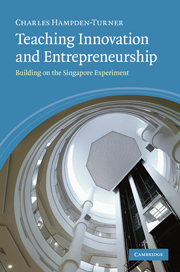Book contents
- Frontmatter
- Contents
- List of grids
- List of dilemmas
- Acknowledgements
- Introduction
- 1 Singapore’s challenge
- 2 The entrepreneurial ecosystem
- 3 How can innovative pedagogies be measured?
- 4 Co-defining innovative education
- 5 The Singapore results
- 6 Results of the Mandarin-speaking programme
- 7 Reconciling values
- 8 ‘It is only the Hawthorne Effect’
- 9 The programme that cannot stand still
- 10 Innovation and the future of the university
- 11 What are the implications of being able to teach innovation?
- 12 Is a new creative class arising?
- Notes
- Bibliography
- Appendices
- General index
- Index of dilemmas and reconciliations
1 - Singapore’s challenge
Published online by Cambridge University Press: 05 July 2014
- Frontmatter
- Contents
- List of grids
- List of dilemmas
- Acknowledgements
- Introduction
- 1 Singapore’s challenge
- 2 The entrepreneurial ecosystem
- 3 How can innovative pedagogies be measured?
- 4 Co-defining innovative education
- 5 The Singapore results
- 6 Results of the Mandarin-speaking programme
- 7 Reconciling values
- 8 ‘It is only the Hawthorne Effect’
- 9 The programme that cannot stand still
- 10 Innovation and the future of the university
- 11 What are the implications of being able to teach innovation?
- 12 Is a new creative class arising?
- Notes
- Bibliography
- Appendices
- General index
- Index of dilemmas and reconciliations
Summary
No longer can we be just a production site for multinational corporations. We will have to be able to generate new knowledge and innovation of our own and commercialise them effectively.
Teo Ming Kian, ‘Empowering Technopreneurs’It is no coincidence that Singapore has been the first to take up this challenge. It has world-class strengths but one major weakness, which we shall examine presently. Colonized by the British, it had the good fortune to be acquired by a benign founder. Sir Stamford Raffles was very much a Renaissance Man, linguist, botanist and gentleman scholar. Raffles is everywhere in Singapore, in streets, squares, quays, drives, avenues, clubs and centres. He carved the whole city into ethnic enclaves and built a free market. He was at heart multi-cultural and defied the Foreign Office by announcing his annexation of Singapore on behalf of the Crown before he had received permission from his superiors.
Business Class on Singapore Airlines is called Raffles Class and a Singapore Sling at the Long Bar in Raffles Hotel is a destination for many tourists. I sought advice from the Permanent Secretary to the Prime Minister’s Office located in the Raffles Tower. Rarely has a single name been put to so many uses. Singaporeans are comfortable with authority and have benefited historically from its good judgement.
Singapore was cast out of the Malaysian Federation in 1965, which had earlier gained its independence from Britain in 1957. Singapore was not expected to survive, politically or economically. Its leader Lee Kuan Yew, a lawyer with a Double First degree from Cambridge University, was visibly distressed. How could one crowded city, without adequate material resources, or even enough water, survive in any form? The Japanese had overrun it in 48 hours in 1942.
- Type
- Chapter
- Information
- Teaching Innovation and EntrepreneurshipBuilding on the Singapore Experiment, pp. 7 - 21Publisher: Cambridge University PressPrint publication year: 2009



